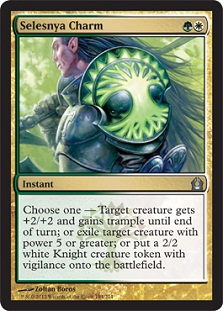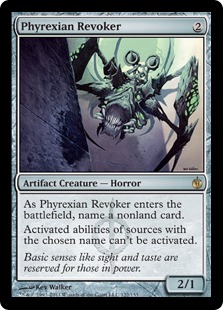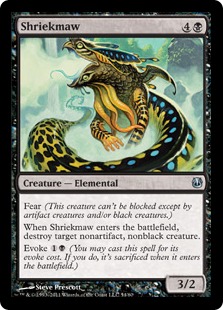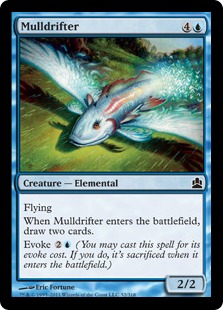In previous articles, I discussed cards like Smokestack and Life from the Loam—cards that have multiple uses in many different Cube decks. However, there are many more cards in Cube, like the newly spoiled Charms, that derive value from serving multiple purposes in a game itself. In this article, I’ll be discussing the role of cards that can do multiple things and their uses in cubes.
There aren’t many literal Charm cards that are in cubes nowadays, aside from cubes that have larger tricolor sections with some of the Alara block Charms like Esper Charm. However, there are a lot of Cube cards that perform various tasks where you pay some form of premium for the versatility. After all, isn’t Disenchant just a two-mode Charm with Smelt and Demystify as its options? Isn’t Pillage a sorcery speed Charm with Stone Rain and Smelt modes? If you think of it in that way, we start to see more of these "Charm" type cards come to the forefront. Before going more in-depth about those kinds of cards, I’ll discuss their evaluation with the ones that have been spoiled thus far at the time of this writing: Selesnya Charm, Izzet Charm, and Azorius Charm.
A lot of the modes on the Charms seem to be at about 1-3 mana cost. The mass lifelink on Azorius Charm is a good deal for its cost, as Stir the Pride was at 4W (which we can safely reduce to 3W for the entwine cost). Selesnya Charm’s Knight ability should be valued at about three mana. Â
Although it seems like there’s a lot of Izzet left to be spoiled, Izzet Charm does look like it has the best chance of making it into cubes. Also, as competition isn’t as strong in Izzet versus Selesnya and Azorius (with them getting Detention Sphere and Supreme Verdict as relatively easy includes), it should be an easy include. Golgari is getting a ton of good cards like Vraska the Unseen, Lotleth Troll, and Abrupt Decay, so Golgari Charm will likely have to be insane to crack the cube ranks. But Rakdos Charm has some potential, especially if it has something like Lava Spike as one of its modes and some decently disruptive abilities like hand disruption. One thing is for sure: versatile cards are an important part of the Cube metagame.
It can be easy to look at something like Izzet Charm and discount it because all of its modes should be valued at about one mana and some of them compare poorly to other modes. Almost no one plays Shock, and the damage-dealing mode is worse on Izzet Charm. Regardless, when I tested Izzet Charm I found that it was a very solid card. It wasn’t because any of the modes were on-curve for their cost (like Pillage), but because all of the modes fit together well with what the archetype wants to do (kill small things in the early game, counter big things, and Loot away things like lands).
One of the questions that I get asked when it comes to "answer" cards in Cube is which ones should be run in a cube and which ones you should use in a deck since there are a lot of answers for opposing permanents at various points on the mana curve, from Nature’s Claim to Wickerbough Elder to Woodfall Primus. I briefly discussed the topic in the "second fiddle" article, but I’ll discuss the topic further.
One of the important things to do during the deckbuilding phase is to identify your deck’s path to victory. The key to successful flexible cards is for them to align with your deck’s path to victory. As discussed before, cards like Pillage work well in red aggressive decks since they go along with the red aggro plan of winning through disruption (by either destroying lands or other mana rocks) as well as being a general catchall answer for other things like equipment or annoying artifact creatures. Similarly, a card like Phyrexian Revoker or Torch Fiend works well in that same deck because it works as an on-curve creature that acts as an answer to opposing threats while working within what the deck wants to do.
Granted, two-mana 2/1s aren’t setting any world records for efficiency, but they work with the aggressive red deck’s goal of playing guys and smashing face while disrupting the opponent’s defenses. It’s the same reason why the damage on Molten Rain and Smash to Smithereens helps those cards be more playable—those cards also align with what aggressive decks want to do, even if they’re not really flexible cards, but the extra value through damage helps them align with the deck’s goals.
Of course, this will vary from deck to deck, and as a cube designer, it’s important to keep these various archetypes in mind when providing answers. A deck like R/G midrange wants to have something like Indrik Stomphowler as its answer, whereas a deck like R/G aggro would rather use something like Smash to Smithereens or Pillage. Generally, answers that are attached to bodies are better and tend to get played more as they help act as damage sources (Uktabi Orangutan will get more maindeck play than something like Oxidize or Nature’s Claim), even if the bodies are on the weak/temporary side, such as on creatures like Keldon Vandals, Avalanche Riders, or Mortarpod.
However, as discussed in the "second fiddle" article, we have many options to choose from. When it comes to flexibility for answers, we have a lot of choices. For example, many cubes use the card Disenchant for artifact and enchantment hate, and others use Seal of Cleansing in addition. There’s also Revoke Existence, a card that trades the option of having it stay on the battlefield versus exiling the offending permanent.
Is the versatility of exiling (and thus helping to deal with things like Wurmcoil Engine) better than the seal ability on Seal of Cleansing? I don’t think that it is. However, it still may be right to use all three of those cards. It really depends on how you want to craft your environment and if you feel that you need the third spell to deal with opposing artifacts and enchantments, like if those cards are consistently high-performing cards that require another card to answer them. As Evan Erwin said, it’s all really seasoning to taste.
So how do we determine which flexible cards should be used? How do we determine how flexible a card actually is? For that, I sometimes turn to using data.
When I saw Abrupt Decay, I knew that it has a lot of potential targets in my cube, especially since I have a powered cube. The Moxen are a few cards that were easy to see as potential targets. I thought about the different cards that it could target, like Azorius Signet, Mother of Runes, and Grafted Wargear, and the gears were turning. Still, I wasn’t sure, so I turned to a method that I frequently use: counting the targets. Using data is a useful tool for cube designers as, like testing the cards, it helps to remove some of the theoretical feel of card evaluation and helps quantify them. In other words, I know that Azorius Signet and friends are Abrupt Decay targets, but how many are there total? So I looked.
Out of the 450 cards in my cube, I found that 186 of the cards are good targets for Abrupt Decay. There are some other cards (24) that I consider to be dubious targets, like tokens from Wurmcoil Engine and token generators like Hornet Queen, and 240 cards are invalid targets. I used a card like Doom Blade to find "dubious" (16), "good" (158), and invalid (276) targets in my cube, and when I compared it to a card like Naturalize (4,76,370), I was happy to put Abrupt Decay in my cube. To summarize, I found the cards that it would target and used other cards as a benchmark for comparison.
Of course, this method isn’t an ironclad method since if you do this you need to critically evaluate the data that you’re using. For example, you can Abrupt Decay a Sakura-Tribe Elder, Mogg Fanatic, or Black Lotus and force someone to sacrifice those cards earlier than they would want to (I’ve Frost Titan locked down Black Lotuses that got Bloodbraid Elfed into play in my day), but generally, that isn’t really what I would consider a prime use of a card like Abrupt Decay. It’s a nice side effect if you really need to kill a Sakura-Tribe Elder that’s threatening to block your Wurmcoil Engine, but it’s much worse than something like Abrupt Decaying a Sulfuric Vortex. It’s not a real reason that you play the card, and thus that is why I consider those to be "dubious" uses.
There are also other factors that are harder to quantify. For example, it’s difficult to say whether it’s better to Doom Blade something like an Avenger of Zendikar / Consecrated Sphinx versus Abrupt Decaying a Sword of Fire and Ice. Sure, you’re getting a big tempo advantage from the Doom Blade killing the bigger finishers, but it’s difficult to say which would provide more actual value. Because of this, I usually keep all targets as equal. However, I have seen people overestimate the versatility of some cards because of this factor, such as cards like Aven Mindcensor where the opponent may only have one or two targets for it. It’s important to keep that in mind as well when designing and drafting a cube.
That being said, when thinking about using flexible cards it’s important to be mindful of card efficiency. It can be very easy to go down a slippery slope when it comes to evaluating cards for Cube by way of comparing them to cards at or below their mana costs. Before people realized the power of aggressive strategies in Cube, people looked down on cards like Jackal Pup and Carnophage saying, "Why would I play those cards when, for just one more mana, I can have Goblin Piker and Grizzly Bears?" Of course, this discounted the value from the one-mana reduction, the reason why these cards were efficient in the first place.
A thing that I noticed was that although I absolutely loved Acidic Slime in Cube, I was not as much a fan of cards like Mold Shambler and Brutalizer Exarch. Why was that? I found that for my cube’s environment and size that six mana was too much for that effect, as my other flexible answers were doing the job to the point where I did not need the six-mana creatures. I also really wanted to like Bramblecrush, but at the size my cube is at now, I found that four mana was too much mana for a one-for-one trade (aside from Faith’s Fetters).
I’m not saying that Bramblecrush and Mold Shambler are bad cards for Cube. I just felt that my other flexible answers like Acidic Slime were doing the job better and more efficiently.
Lastly on the topic of flexible cards, there are other cards that are flexible across various phases of the game.
While the old standby cards of Burst Lightning, Shriekmaw, and Mulldrifter have been accepted as Cube staples, cards that are flexible across various phases of the game tend to get underrated by people when they’re initially spoiled. It’s probably because people tend to think not so much about their flexibility but think of direct comparisons to other cards at the same mana cost and forget about their flexibility. ("Why would I play Everflowing Chalice if it’s just going to be worse than Mind Stone at two mana and worse than Thran Dynamo at 4 mana?")
Having cards like these helps give reach to decks as well as flexibility. The key for phase-flexible cards is for them to have one side where they can be used for an on-par value in Cube, such as casting Burst Lightning as a "Shock" or Kargan Dragonlord’s ability to be cast as a RR 2/2. None of these modes set any efficiency records, but they’re on curve and can be used flexibly. Also, like Pillage, their "extra" modes go along well with what the deck wants to do.
I haven’t had much of a chance to see Mizzium Mortars in action in my cube yet, but Cyclonic Rift is a card that I have been pleasantly surprised with. It usually played out as decent on turn 2 and randomly blew people out on turn 7 or helped the player have a bit of reprieve after getting to seven mana. I have heard people say that it is worse than other common seven-mana effects in Cube like Karn Liberated and Myr Battlesphere, but this ignores the flexibility from its two-mana side and is a disingenuous evaluation. Will Cyclonic Rift end up making it into my cube? For now, I don’t know, but because I evaluated the value of its flexibility through its overload, I was able to give it a proper chance in testing. This may not have happened if I had dismissed it as a bad seven-mana spell.
I hope that this article has given you some insight into how flexible cards play a role in Cube and how to manage and use them in your cube.
May all of your opening packs contain Sol Rings!
@UsmanTheRad on Twitter
http://idratherbecubing.wordpress.com – my blog featuring my cube lists.
The Third Power: A Cube podcast featuring myself and Anthony Avitollo!














